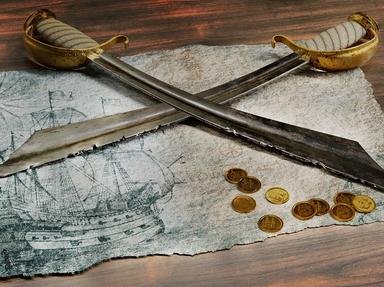Quiz Answer Key and Fun Facts
1. Who was this Scotsman, who as a privateer, loaned the runner and tackle from his ship for hoisting the stones that were used in construction of New York's Trinity Church? (He was later hanged in chains in England as a pirate.)
2. Edward Teach, also known more infamously as "Blackbeard", took over a French merchant ship, "La Concorde", and converted it into his flagship. He increased the armament to 40 guns, and re-named the ship. What did he call this ship?
3. Was there a pirates' "code of conduct"? Now who on earth would have come up with that concept?
4. This Welshman held the following titles and 'job descriptions' during his lifetime: buccaneer, pirate, admiral and general, country gentleman and planter, judge of the court of Vice-Admiralty, governor and knight. Who was this colorful character who gave the Spanish such horrible fits in the Caribbean Sea and on the Spanish Main?
5. "Walking the plank" was one of the most favored forms of punishments for infractions that ran against the pirates' code.
6. Francis Spriggs had spent his early seafaring years as the quartermaster of a ship commanded by Captain Edward Low. Around Christmas of 1724, he deserted Low's ship in the middle of the night. Where did he immediately flee to?
7. Aaah! That wonderful Golden Age Of Piracy! Well, maybe it wasn't quite so "golden" after all. Let's face it, it was a pretty miserable existence for the most part, filled with starvation diets, petty larcency, danger of death at the hands of other pirates. Probably the worst thing, though, was the lack of any female pirates. There just weren't any at all.
8. What is the origin of the term "buccaneer", a term commonly understood as synonomous with the word "pirate"?
9. John Rackham had not one but TWO female pirates aboard his ship. This was highly unusual, to say the least, as most pirate codes specifically forbade women on board at all. The two women were Mary Read and his lover, Anne Bonny, the former wife of a sailor named James Bonny. John Rackham was often called by another name. What nickname was he better known by?
10. Imagine this: a man who sailed for a time with the notorious pirate, Blackbeard, was known as "The Gentleman Pirate". Who was this wealthy (and most likely mentally unstable) planter in Barbados who decided to turn to a life of piracy to avoid either a) boredom or b) his wife or c) both?
Source: Author
logcrawler
This quiz was reviewed by FunTrivia editor
bloomsby before going online.
Any errors found in FunTrivia content are routinely corrected through our feedback system.


